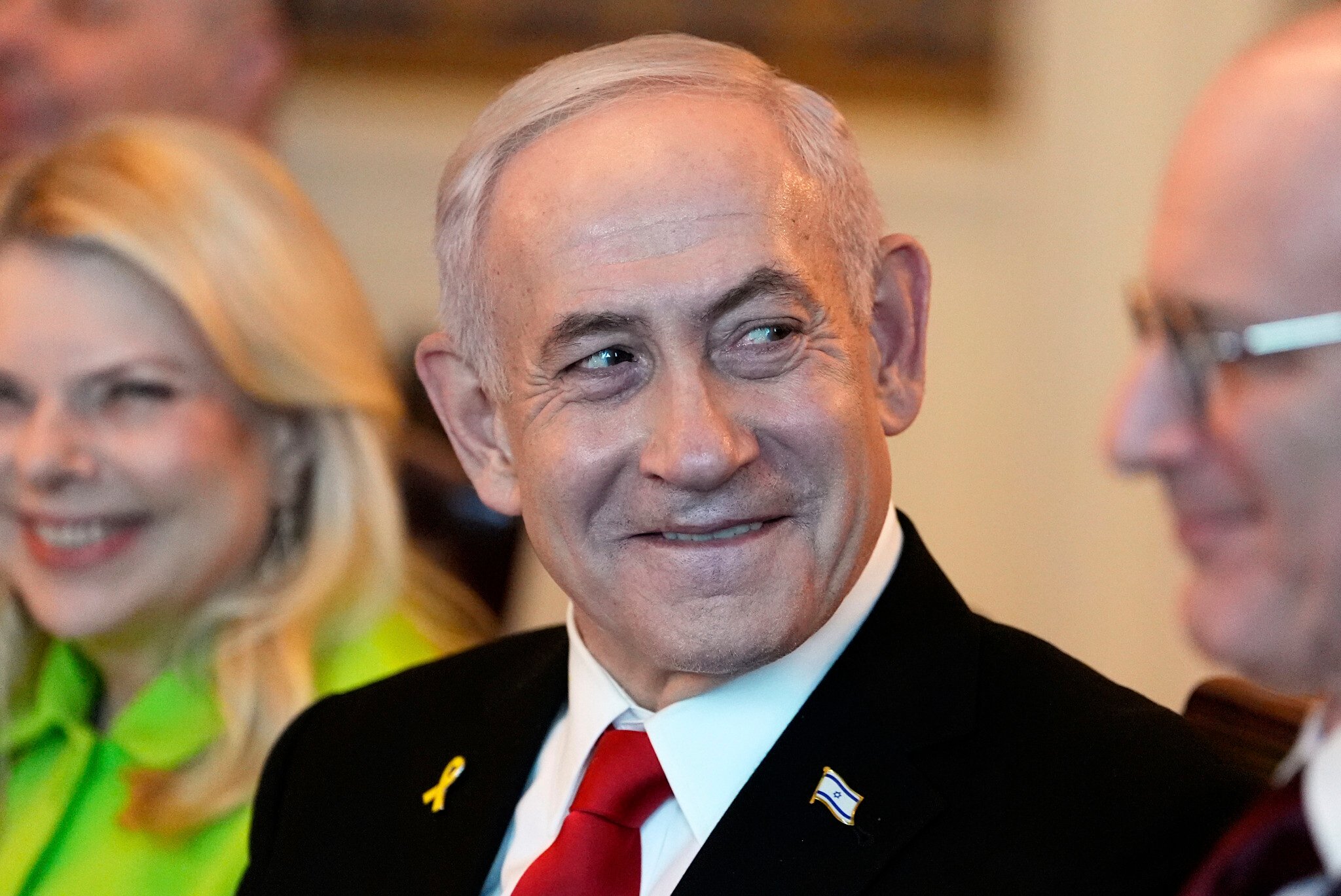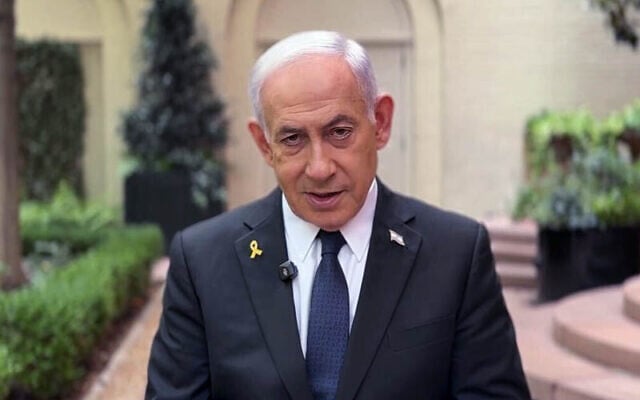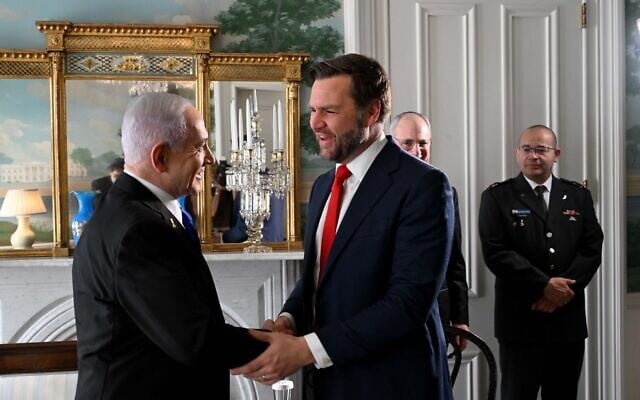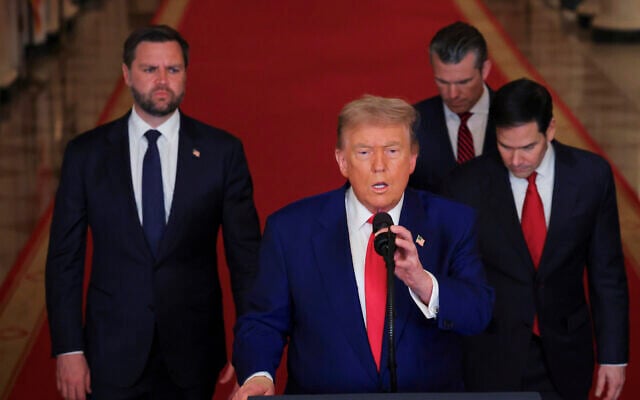



WASHINGTON — In a rare move for this prime minister, Benjamin Netanyahu traveled home on Thursday on his scheduled return flight without extending his visit to Washington through the weekend.
He did delay the flight a few hours, however, to take a detour to Monticello, the historic plantation of Thomas Jefferson.
If Netanyahu took time at the site to study the way of war espoused by America’s third president, he may have seen a contrast to one of his own most fateful blunders.
For years after the founding of the United States, Barbary privateers preyed on American ships in the Mediterranean, with Congress paying humiliating tributes to the Barbary States to protect their merchants. But when Jefferson assumed office in 1801, he decided to end the payments and go to war.
“We prefer war in all cases to tribute under any form and to any people whatever,” he wrote.
For years, Netanyahu took the opposite approach in dealing with the Hamas threat from Gaza. From 2018, he allowed suitcases holding millions in Qatari cash to enter Gaza through Israeli crossings, in order to maintain a fragile ceasefire with the Hamas rulers of the Strip.

He, and all of Israel, would have been better off taking the Jeffersonian path. The payments to Hamas didn’t buy peace. Instead, they allowed the terror group to further build up its army as it prepared the October 7, 2023, invasion.
Netanyahu was in Washington to discuss with US President Donald Trump a deal in which Hamas would free half the remaining hostages its terrorists kidnapped on that day in exchange for a ceasefire.
He insists it is no capitulation, but a road bump on the way to “total victory.” Hours before he took off for Monticello, Netanyahu released a video statement in which he continued to insist that the war in Gaza would not end before Hamas is forced to accept Israel’s terms, even if a ceasefire is agreed upon: “Hamas lays down its weapons, Gaza is demilitarized, Hamas no longer has any governmental or military capabilities. These are our basic conditions.”

“If this can be achieved through negotiations — that’s great,” he said. “If it is not achieved through negotiations in 60 days, we will achieve it in other ways; by using force, the force of our heroic army.”
Despite his threats, Israel’s military operations in Gaza are still designed to reach a deal, not to defeat Hamas.
“Our forces are landing powerful blows that will get stronger against Hamas strongholds that still exist in Gaza,” Netanyahu said in May, promising that “all the territory of Gaza will be under Israeli security control, and Hamas will be totally defeated.”
Yet, as in previous phases of the war against Hamas, after an aggressive start to the latest operation, dubbed “Gideon’s Chariots,” IDF troops are once again largely stuck in place.

Cutting off aid to Gaza in March didn’t force Hamas to accept Israel’s terms, nor did seizing over two-thirds of the Strip’s territory. The much-maligned Gaza Humanitarian Foundation initiative has not yet caused Hamas civil rule to collapse, and Israel is again leaning heavily on the United Nations for aid deliveries.
Instead, it was Israel that made concessions, accepting a Qatari proposal for releases of living hostages and bodies of the slain across a 60-day ceasefire, and accepting new lines of military withdrawal after Hamas rejected the initial maps.
Despite the lack of progress in talks, expectations for a breakthrough spiked with Netanyahu’s trips to see Trump. Anonymous officials spoke about the possibility of a ceasefire while Netanyahu was in Washington, and observers expected the US president to make a dramatic announcement of a truce with the prime minister at his side.

Instead, optimism slowly dissipated throughout the week as sources from Israel, Hamas, and the mediating countries told reporters about talks stuck over the same issues that caused previous rounds of negotiations to fail.
The lack of progress could have turned Netanyahu’s third White House visit since Trump returned to office into a diplomatic minefield. The US president is notorious for turning on his allies, as evidenced by the feud with Elon Musk that continued to expand while Netanyahu was in town. He still hasn’t managed to end the Russia-Ukraine war, and bringing about an end to the Gaza conflict seems a likelier diplomatic win.
“We’ve got to get that solved. Gaza is a tragedy,” Trump told his cabinet this week.

Trump could have turned the screws on Netanyahu — in private or in front of the cameras — in order to push Israel to accept that a ceasefire would be the first phase in permanently ending the war. But he didn’t. Instead, Trump lavished praise on his guest.
Over dinner in the White House, he told reporters that the two “had a tremendous success together, and I think it will only go on to be even greater success in the future.”
He let Netanyahu lead when asked about a Palestinian state and his plan to relocate Gazans. He threatened to intervene if New York City mayoral candidate Zohran Mamdani, feared by many Jews as anti-Israel, “doesn’t behave” if he wins, including around his pledge to arrest Netanyahu if the premier visited the city.
Netanyahu’s meetings with JD Vance, who has taken a more isolationist lane than Trump, also seemed as warm as could be.

And Defense Minister Pete Hegseth called Israel “a model ally.”
“You can have a lot of allies and then you have allies with capabilities that actually execute on the front lines,” he said in the Pentagon.
Hegseth was referring, of course, to Israel’s 12-day operation against Iran’s nuclear program, which the US joined after Israeli pilots and intelligence services racked up a string of stunning successes.
That is the key to the maneuvering room Netanyahu enjoys, even as Trump’s desired outcome remains frustratingly out of reach.
While European and Asian allies are unable to provide for their own security without massive US involvement, Israel stands out in its willingness to fight and sacrifice. Even that would have limited value in Trump’s eyes if all of its wars were inconclusive as its Gaza operation. Yet against Hezbollah, and against Iran, Israel was able to craft daring, technologically impressive, and effective campaigns that were short and contained.

Israel’s successes in degrading Iran’s air defenses and eliminating its military leaders opened the door for Trump to look tough and judicious with his use of military force. His Operation Midnight Hammer lasted only a few hours, involved no ground troops, and saw the US sustain no casualties. Unlike his predecessors, Trump can say, his operations in the Middle East did not come at significant cost, and did not drag on with questionable purpose.
Trump, Hegseth, and US Secretary of State Marco Rubio are clearly basking in the afterglow of the strikes, and Netanyahu’s visit — along with his B-2 mezuzah gift — gave them new opportunities to wax at length about the operation in front of cameras.
Moreover, the US military involvement in Israel’s Iran strikes seems to be a political win for Trump as well. Though much has been made about Trump voters’ supposed isolationism, a recent Ronald Reagan Institute survey found that 84 percent of voters want to prevent Iran from obtaining nuclear weapons, with 90% of self-identified MAGA Republicans saying that “preventing Iran from obtaining a nuclear weapon is important to US security.”
“MAGA Republicans” also wanted to see the US leading on international affairs at a higher rate than Republicans as a whole, and a whopping 86% said Israel’s security is important to US security.
Trump likes a winner, and right now, Netanyahu looks like one.
Yet all the good vibes in Washington don’t solve the Gaza conundrum for Netanyahu.
While the polls point in the right direction for Trump, they tell a different story for Netanyahu. Seventy-four percent of Israelis, including 60% of people who voted for his coalition, back an agreement with Hamas that would release all the hostages at once in exchange for an end to the Gaza war, according to a poll aired Friday on Channel 12.
Netanyahu rejects that option, which could spell the demise of his coalition, which is reliant on far-right parties bent on carrying on the war.
